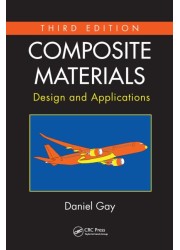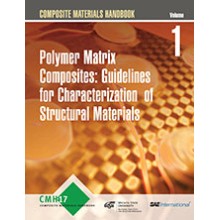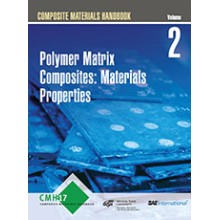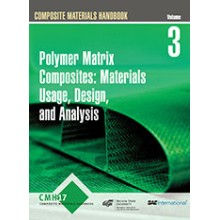Composite Materials: Design and Applications, Third Edition
Quantity:
-
Add to Compare
Considered to have contributed greatly to the pre-sizing of composite structures,Composite Materials: Design and Applications is a popular reference book for designers of heavily loaded composite parts. Fully updated to mirror the exponential growth and development of composites, this English-language Third Edition:
- Contains all-new coverage of nanocomposites and biocomposites
- Reflects the latest manufacturing processes and applications in the aerospace, automotive, naval, wind turbine, and sporting goods industries
- Provides a design method to define composite multilayered plates under loading, along with all numerical information needed for implementation
- Proposes original study of composite beams of any section shapes and thick-laminated composite plates, leading to technical formulations that are not found in the literature
- Features numerous examples of the pre-sizing of composite parts, processed from industrial cases and reworked to highlight key information
- Includes test cases for the validation of computer software using finite elements
Consisting of three main parts, plus a fourth on applications, Composite Materials: Design and Applications, Third Edition features a technical level that rises in difficulty as the text progresses, yet each part still can be explored independently. While the heart of the book, devoted to the methodical pre-design of structural parts, retains its original character, the contents have been significantly rewritten, restructured, and expanded to better illustrate the types of challenges encountered in modern engineering practice.
Table of Contents
Preface
Acknowledgments
Author
Section I: Principles of Construction
Composite Materials: Interest and Physical Properties
What Is a Composite Material?
Broad Definition
Main Features
Fibers and Matrices
Fibers
Materials for Matrices
What Can Be Made Using Composite Materials?
A Typical Example of Interest
Some Examples of Classical Design Replaced by Composite Solutions
Main Physical Properties
Manufacturing Processes
Molding Processes
Contact Molding
Compression Molding
Vacuum Molding
Resin Injection Molding
Injection Molding with Prepreg
Foam Injection Molding
Molding of Hollow Axisymmetric Components
Other Forming Processes
Sheet Forming
Profile Forming
Forming by Stamping
Preforming by Three-Dimensional Assembly
Automated Tape Laying and Fiber Placement
Practical Considerations on Manufacturing Processes
Acronyms
Cost Comparison
Ply Properties
Isotropy and Anisotropy
Isotropic Materials
Anisotropic Material
Characteristics of the Reinforcement/Matrix Mixture
Fiber Mass Fraction
Fiber Volume Fraction
Mass Density of a Ply
Ply Thickness
Unidirectional Ply
Elastic Modulus
Ultimate Strength of a Ply
Examples
Examples of High-Performance Unidirectional Plies
Woven Ply
Forms of Woven Fabrics
Elastic Modulus of Fabric Layer
Examples of Balanced Fabric/Epoxy
Mats and Reinforced Matrices
Mats
Example: A Summary of Glass/Epoxy Layers
Microspherical Fillers
Other Classical Reinforcements
Multidimensional Fabrics
Example: A 4D Architecture of Carbon Reinforcement
Example: Three-Dimensional Carbon/Carbon Components
Metal Matrix Composites
Some Examples
Unidirectional Fibers/Aluminum Matrix
Biocomposite Materials
Natural Plant Fibers
Natural Vegetable Fiber–Reinforced Composites
Manufacturing Processes
Nanocomposite Materials
Nanoreinforcement
Nanocomposite Material
Mechanical Applications
Manufacturing of Nanocomposite Materials
Tests
Sandwich Structures
What Is a Sandwich Structure?
Their Properties Are Surprising
Constituent Materials
Simplified Flexure
Stress
Displacements
Some Special Features of Sandwich Structures
Comparison of Mass for the Same Flexural Rigidity 〈EI〉
Deterioration by Buckling of Sandwich Structures
Other Types of Damage
Manufacturing and Design Problems
Example of Core Material: Honeycomb
Shaping Processes
Inserts and Attachment Fittings
Repair of Laminated Facings
Nondestructive Inspection
Main Nondestructive Inspection Methods
Acoustic Emission Testing
Conception: Design and Drawing
Drawing a Composite Part
Specific Properties
Guide Values of Presizing
Laminate
Unidirectional Layers and Fabrics
Correct Ply Orientation
Laminate Drawing Code
Arrangement of Plies
Failure of Laminates
Damages
Most Frequently Used Criterion: Tsai–Hill Failure Criterion
Presizing of the Laminate
Modulus of Elasticity—Deformation of a Laminate
Case of Simple Loading
Complex Loading Case: Approximative Proportions according to Orientations
Complex Loading Case: Optimum Composition of a Laminate
Notes for Practical Use Concerning Laminates
Conception: Fastening and Joining
Riveting and Bolting
Local Loss of Strength
Main Failure Modes in Bolted Joints of Composite Materials
Sizing of the Joint
Riveting
Bolting
Bonding
Adhesives Used
Geometry of the Bonded Joints
Sizing of the Bonding Surface Area
Case of Bonded Joint with Cylindrical Geometry
Examples of Bonding
Inserts
Case of Sandwich Parts
Case of Parts under Uniaxial Loads
Composite Materials and Aerospace Construction
Aircraft
Composite Components in Aircraft
Allocation of Composites Depending on Their Nature
Few Comments
Specific Aspects of Structural Strength
Large Transport Aircraft
Regional Aircraft and Business Jets
Light Aircraft
Fighter Aircraft
Architecture and Manufacture of Composite Aircraft Parts
Braking Systems
Helicopters
Situation
Composite Areas
Blades
Rotor Hub
Other Working Composite Parts
Airplane Propellers
Propellers for Conventional Aerodynamics
High-Speed Propellers
Aircraft Reaction Engine
Employed Materials
Refractory Composites
Space Applications
Satellites
Propellant Tanks and Pressure Vessels
Nozzles
Other Composite Components for Space Application
Composite Materials for Various Applications
Comparative Importance of Composites in Applications
Relative Importance in terms of Mass and Market Value
Mass of Composites Implemented according to the Geographical Area
Average Prices
Composite Materials and Automotive Industry
Introduction
Composite Parts
Research and Development
Motor Racing
Wind Turbines
Components
Manufacturing Processes
Composites and Shipbuilding
Competition
Vessels
Sports and Leisure
Skis
Bicycles
Tennis Rackets
Diverse Applications
Pressure Gas Bottle
Bogie Frame
Tubes for Offshore Installations
Biomechanical Applications
Cable Car
Section II: Mechanical Behavior of Laminated Materials
Anisotropic Elastic Medium
Some Reminders
Continuum Mechanics
Number of Distinct φijkℓ Terms
Orthotropic Material
Transversely Isotropic Material
Elastic Constants of Unidirectional Composites
Longitudinal Modulus Eℓ
Poisson Coefficient
Transverse Modulus Et
Shear Modulus Gℓt
Thermoelastic Properties
Isotropic Material: Recall
Case of Unidirectional Composite
Thermomechanical Behavior of a Unidirectional Layer
Elastic Constants of a Ply in Any Direction
Flexibility Coefficients
Stiffness Coefficients
Case of Thermomechanical Loading
Flexibility Coefficients
Stiffness Coefficients
Mechanical Behavior of Thin Laminated Plates
Laminate with Midplane Symmetry
Membrane Behavior
Apparent Elastic Moduli of the Laminate
Consequence: Practical Determination of a Laminate Subject to Membrane Loading
Flexure Behavior
Consequence: Practical Determination of a Laminate Subject to Flexure
Simplified Calculation for Bending
Thermomechanical Loading Case
Laminate without Midplane Symmetry
Coupled Membrane–Flexure Behavior
Case of Thermomechanical Loading
Section III: Justifications, Composite Beams, and Thick Laminated Plates
Elastic Coefficients
Elastic Coefficients for an Orthotropic Material
Reminders
Elastic Behavior Equation in Orthotropic Axes
Elastic Coefficients for a Transverse Isotropic Material
Elastic Behavior Equation
Rotation about an Orthotropic Transverse Axis
Case of a Ply
Damage in Composite Parts; Failure Criteria
Damage in Composite Parts
Industrial Emphasis of the Problem
Influence of Manufacturing Process
Typical Area and Singularities in a Same Part
Degradation Process within the Typical Area
Form of a Failure Criterion
Features of a Failure Criterion
General Form of a Failure Criterion
Linear Failure Criterion
Quadratic Failure Criterion
Tsai–Hill Failure Criterion
Isotropic Material: The von Mises Criterion
Orthotropic Material: Tsai–Hill Criterion
Evolution of Strength Properties of a Unidirectional Ply Depending on the Direction of Solicitation
Bending of Composite Beams of Any Section Shape
Bending of Beams with Isotropic Phases and Plane of Symmetry
Degrees of Freedom
Write a review
Your Name:Your Review: Note: HTML is not translated!
Rating: Bad Good
Enter the code in the box below:
Copyright © 2014 Engineering Standards Bureau. All Rights Reserved.
Developed By Zoom Into Web







